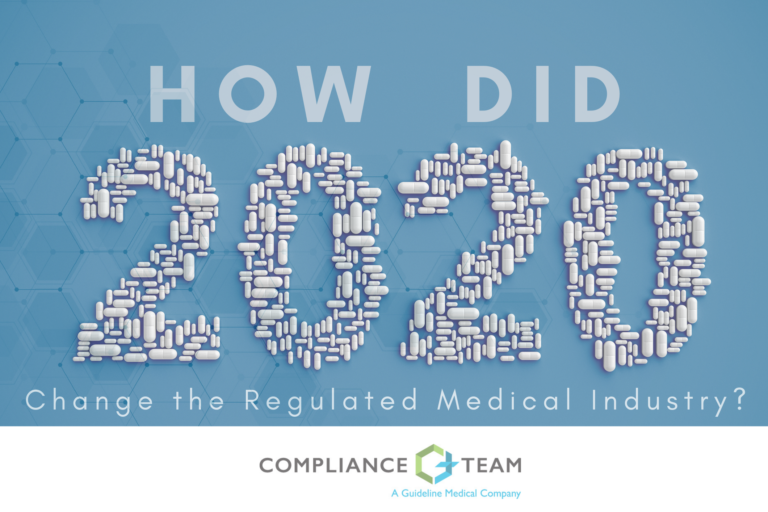5 Ways 2020 Changed Regulated Medical Industry
access_timeDecember 17, 2020

By Regina Fullin, V.P. RA/QA Consulting, Compliance Team, LLC
- Use of the remote option. Everything went remote in 2020. Whether it’s working from home, delivery of goods from internet shopping, or telehealth, more people exercised the remote option, rather than risking safety and health through face-to-face contact. The U.S. Food and Drug Administration (FDA) started performing remote inspections to keep its investigators safe from the hazards of airline travel, while supplier audits and other business took place remotely. Video conferencing is here to stay, while entities offering in-person options, such as airlines and commercial office space, will decline, as companies discovered that such expenses were often unessential.
- Deferred enforcement of new regulations. During a pandemic, you focus on what’s important. Enforcement of new regulations often takes a back seat to crisis response. During the pandemic, enforcement of the Drug Supply Chain Security Act (DSCSA), Unique Device Identifier (UDI) Final Rule, and European Union Medical Device Regulation (EU-MDR) has relaxed. Certainly, once the world recovers from the pandemic, these, and other new regulations will resume enforcement. For now, industry can relax a bit while they focus on creating new therapies to address the public health crisis, and revival of a rarely used type of marketing authorization.
- The “Emergency Use Authorization,” has come into widespread use. Desperate times call for desperate measures. Not only have new regulations experienced deferred enforcement, but the FDA, seeing a public health emergency, activated a regulatory path for introduction of new therapies to address the public health crisis. The Emergency Use Authorization (EUA) waives some of the requirements for proof of safety and effectiveness, to ensure that availability of therapies is not a limiting factor on patient survival. Newly fast-tracked products can begin realizing revenue before receipt of full marketing clearance. This is a win/win for companies, patients, and caregivers who are coping with the pandemic, and have given some companies a head start that will benefit them in the years to come.
- Genetically engineered vaccines are here. Traditional vaccines were produced by inactivating a live pathogen, or by harvesting key proteins (antigens) from the pathogen and injecting these proteins in the human body to produce an immune response. The rush to market a vaccine provided a fast-track to investigate a new method of vaccine delivery, which had not previously been approved for humans. The new method involves encapsulating genetic instructions (mRNA) in a virus or similar, so the human body can manufacture the antigens that produce the immune response. Theoretically, this improves vaccine effectiveness because the amount of antigen is no longer limited by the dose, because the body can produce as much antigen as is needed. If the new COVID-19 vaccines are found safe and effective over time, it will revolutionize how vaccines are manufactured and administered in the future.
- Made in the USA is elevated in importance. Another barrier to availability of therapies was the need to import them from outside the U.S. In a worldwide public health emergency, each nation must look after serving its own population before exporting important medical gear to foreign countries. The U.S. imports numerous Active Pharmaceutical Ingredients (APIs) and medical equipment to save production costs, at the expense of opportunity cost. Production based overseas results in a less agile supply chain, delaying critical medical supplies when needed most. The year 2020 taught us that sometimes it pays to bring foreign manufacturing back to U.S. soil.